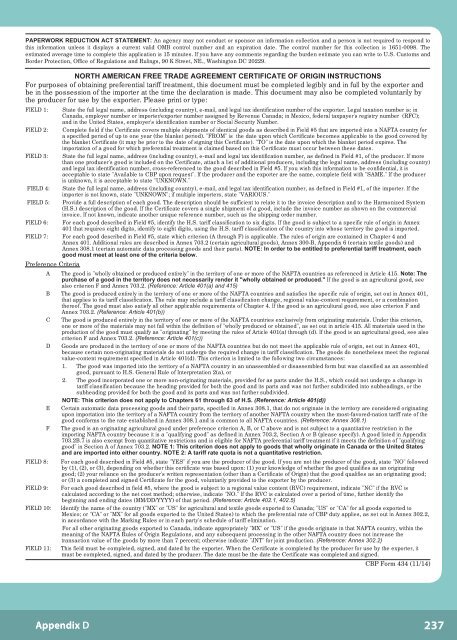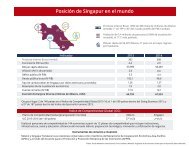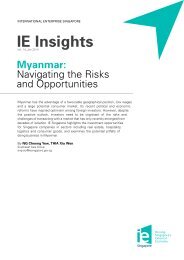basic-guide-to-exporting_Latest_eg_main_086196
basic-guide-to-exporting_Latest_eg_main_086196
basic-guide-to-exporting_Latest_eg_main_086196
You also want an ePaper? Increase the reach of your titles
YUMPU automatically turns print PDFs into web optimized ePapers that Google loves.
PAPERWORK REDUCTION ACT STATEMENT: An agency may not conduct or sponsor an information collection and a person is not required <strong>to</strong> respond <strong>to</strong>this information unless it displays a current valid OMB control number and an expiration date. The control number for this collection is 1651-0098. Theestimated average time <strong>to</strong> complete this application is 15 minutes. If you have any comments r<strong>eg</strong>arding the burden estimate you can write <strong>to</strong> U.S. Cus<strong>to</strong>ms andBorder Protection, Office of R<strong>eg</strong>ulations and Rulings, 90 K Street, NE., Washing<strong>to</strong>n DC 20229.NORTH AMERICAN FREE TRADE AGREEMENT CERTIFICATE OF ORIGIN INSTRUCTIONSFor purposes of obtaining preferential tariff treatment, this document must be completed l<strong>eg</strong>ibly and in full by the exporter andbe in the possession of the importer at the time the declaration is made. This document may also be completed voluntarily bythe producer for use by the exporter. Please print or type:FIELD 1: State the full l<strong>eg</strong>al name, address (including country), e-mail, and l<strong>eg</strong>al tax identification number of the exporter. L<strong>eg</strong>al taxation number is: inCanada, employer number or importer/exporter number assigned by Revenue Canada; in Mexico, federal taxpayer's r<strong>eg</strong>istry number (RFC);and in the United States, employer's identification number or Social Security Number.FIELD 2: Complete field if the Certificate covers multiple shipments of identical goods as described in Field #5 that are imported in<strong>to</strong> a NAFTA country fora specified period of up <strong>to</strong> one year (the blanket period). "FROM" is the date upon which Certificate becomes applicable <strong>to</strong> the good covered bythe blanket Certificate (it may be prior <strong>to</strong> the date of signing this Certificate). "TO" is the date upon which the blanket period expires. Theimportation of a good for which preferential treatment is claimed based on this Certificate must occur between these dates.FIELD 3: State the full l<strong>eg</strong>al name, address (including country), e-mail and l<strong>eg</strong>al tax identification number, as defined in Field #1, of the producer. If morethan one producer's good is included on the Certificate, attach a list of additional producers, including the l<strong>eg</strong>al name, address (including country)and l<strong>eg</strong>al tax identification number, cross-referenced <strong>to</strong> the good described in Field #5. If you wish this information <strong>to</strong> be confidential, it isacceptable <strong>to</strong> state "Available <strong>to</strong> CBP upon request". If the producer and the exporter are the same, complete field with "SAME." If the produceris unknown, it is acceptable <strong>to</strong> state "UNKNOWN."FIELD 4: State the full l<strong>eg</strong>al name, address (including country), e-mail, and l<strong>eg</strong>al tax identification number, as defined in Field #1, of the importer. If theimporter is not known, state "UNKNOWN"; if multiple importers, state "VARIOUS."FIELD 5: Provide a full description of each good. The description should be sufficient <strong>to</strong> relate it <strong>to</strong> the invoice description and <strong>to</strong> the Harmonized System(H.S.) description of the good. If the Certificate covers a single shipment of a good, include the invoice number as shown on the commercialinvoice. If not known, indicate another unique reference number, such as the shipping order number.FIELD 6: For each good described in Field #5, identify the H.S. tariff classification <strong>to</strong> six digits. If the good is subject <strong>to</strong> a specific rule of origin in Annex401 that requires eight digits, identify <strong>to</strong> eight digits, using the H.S. tariff classification of the country in<strong>to</strong> whose terri<strong>to</strong>ry the good is imported.FIELD 7: For each good described in Field #5, state which criterion (A through F) is applicable. The rules of origin are contained in Chapter 4 andAnnex 401. Additional rules are described in Annex 703.2 (certain agricultural goods), Annex 300-B, Appendix 6 (certain textile goods) andAnnex 308.1 (certain au<strong>to</strong>matic data processing goods and their parts). NOTE: In order <strong>to</strong> be entitled <strong>to</strong> preferential tariff treatment, eachgood must meet at least one of the criteria below.Preference CriteriaA The good is "wholly obtained or produced entirely" in the terri<strong>to</strong>ry of one or more of the NAFTA countries as referenced in Article 415. Note: Thepurchase of a good in the terri<strong>to</strong>ry does not necessarily render it "wholly obtained or produced." If the good is an agricultural good, seealso criterion F and Annex 703.2. (Reference: Article 401(a) and 415)B The good is produced entirely in the terri<strong>to</strong>ry of one or more of the NAFTA countries and satisfies the specific rule of origin, set out in Annex 401,that applies <strong>to</strong> its tariff classification. The rule may include a tariff classification change, r<strong>eg</strong>ional value-content requirement, or a combinationthereof. The good must also satisfy all other applicable requirements of Chapter 4. If the good is an agricultural good, see also criterion F andAnnex 703.2. (Reference: Article 401(b))C The good is produced entirely in the terri<strong>to</strong>ry of one or more of the NAFTA countries exclusively from originating materials. Under this criterion,one or more of the materials may not fall within the definition of "wholly produced or obtained", as set out in article 415. All materials used in theproduction of the good must qualify as "originating" by meeting the rules of Article 401(a) through (d). If the good is an agricultural good, see alsocriterion F and Annex 703.2. (Reference: Article 401(c))D Goods are produced in the terri<strong>to</strong>ry of one or more of the NAFTA countries but do not meet the applicable rule of origin, set out in Annex 401,because certain non-originating materials do not undergo the required change in tariff classification. The goods do nonetheless meet the r<strong>eg</strong>ionalvalue-content requirement specified in Article 401(d). This criterion is limited <strong>to</strong> the following two circumstances:1. The good was imported in<strong>to</strong> the terri<strong>to</strong>ry of a NAFTA country in an unassembled or disassembled form but was classified as an assembledgood, pursuant <strong>to</strong> H.S. General Rule of Interpretation 2(a), or2. The good incorporated one or more non-originating materials, provided for as parts under the H.S., which could not undergo a change intariff classification because the heading provided for both the good and its parts and was not further subdivided in<strong>to</strong> subheadings, or thesubheading provided for both the good and its parts and was not further subdivided.NOTE: This criterion does not apply <strong>to</strong> Chapters 61 through 63 of H.S. (Reference: Article 401(d))E Certain au<strong>to</strong>matic data processing goods and their parts, specified in Annex 308.1, that do not originate in the terri<strong>to</strong>ry are considered originatingupon importation in<strong>to</strong> the terri<strong>to</strong>ry of a NAFTA country from the terri<strong>to</strong>ry of another NAFTA country when the most-favored-nation tariff rate of th<strong>eg</strong>ood conforms <strong>to</strong> the rate established in Annex 308.1 and is common <strong>to</strong> all NAFTA countries. (Reference: Annex 308.1)F The good is an originating agricultural good under preference criterion A, B, or C above and is not subject <strong>to</strong> a quantitative restriction in theimporting NAFTA country because it is a "qualifying good" as defined in Annex 703.2, Section A or B (please specify). A good listed in Appendix703.2B.7 is also exempt from quantitative restrictions and is eligible for NAFTA preferential tariff treatment if it meets the definition of "qualifyinggood" in Section A of Annex 703.2. NOTE 1: This criterion does not apply <strong>to</strong> goods that wholly originate in Canada or the United Statesand are imported in<strong>to</strong> either country. NOTE 2: A tariff rate quota is not a quantitative restriction.FIELD 8: For each good described in Field #5, state "YES" if you are the producer of the good. If you are not the producer of the good, state "NO" followedby (1), (2), or (3), depending on whether this certificate was based upon: (1) your knowledge of whether the good qualifies as an originatinggood; (2) your reliance on the producer's written representation (other than a Certificate of Origin) that the good qualifies as an originating good;or (3) a completed and signed Certificate for the good, voluntarily provided <strong>to</strong> the exporter by the producer.FIELD 9: For each good described in field #5, where the good is subject <strong>to</strong> a r<strong>eg</strong>ional value content (RVC) requirement, indicate "NC" if the RVC iscalculated according <strong>to</strong> the net cost method; otherwise, indicate "NO." If the RVC is calculated over a period of time, further identify theb<strong>eg</strong>inning and ending dates (MM/DD/YYYY) of that period. (Reference: Article 402.1, 402.5)FIELD 10: Identify the name of the country ("MX" or "US" for agricultural and textile goods exported <strong>to</strong> Canada; "US" or "CA" for all goods exported <strong>to</strong>Mexico; or "CA" or "MX" for all goods exported <strong>to</strong> the United States) <strong>to</strong> which the preferential rate of CBP duty applies, as set out in Annex 302.2,in accordance with the Marking Rules or in each party's schedule of tariff elimination.For all other originating goods exported <strong>to</strong> Canada, indicate appropriately "MX" or "US" if the goods originate in that NAFTA country, within themeaning of the NAFTA Rules of Origin R<strong>eg</strong>ulations, and any subsequent processing in the other NAFTA country does not increase thetransaction value of the goods by more than 7 percent; otherwise indicate "JNT" for joint production. (Reference: Annex 302.2)FIELD 11: This field must be completed, signed, and dated by the exporter. When the Certificate is completed by the producer for use by the exporter, itmust be completed, signed, and dated by the producer. The date must be the date the Certificate was completed and signed.CBP Form 434 (11/14)Appendix D237





